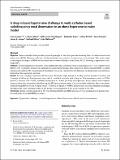| dc.contributor.author | Lauder, Lucas | |
| dc.contributor.author | Moon, L. B | |
| dc.contributor.author | Pipenhagen, Catherine A | |
| dc.contributor.author | Ewen, Sebastian | |
| dc.contributor.author | Fish, Jeffrey M | |
| dc.contributor.author | Virmani, Renu | |
| dc.contributor.author | Jensen, James A | |
| dc.contributor.author | Böhm, Michael | |
| dc.contributor.author | Mahfoud, Felix | |
| dc.date.accessioned | 2021-09-20T17:30:29Z | |
| dc.date.available | 2021-09-20T17:30:29Z | |
| dc.date.issued | 2020-11-02 | |
| dc.identifier.uri | https://hdl.handle.net/1721.1/131828 | |
| dc.description.abstract | Abstract
Objective
Sham-controlled trials provided proof-of-principle for the blood pressure-lowering effect of catheter-based renal denervation (RDN). However, indicators for the immediate assessment of treatment success are lacking. This study sought to investigate the impact of RDN on renal renin arteriovenous difference (renal renin AV-Δ) following a hypotensive challenge (HC).
Methods
Twelve hypertensive Ossabaw swine underwent either combined surgical and chemical (n = 3) or catheter-based RDN (n = 9). A telemetry monitor was implanted to acquire hemodynamic data continuously. Before and after RDN, a sodium nitroprusside-induced HC was performed. Renal renin AV-Δ was calculated as the difference of plasma renin concentrations drawn from the renal artery and vein.
Results
In total, complete renal renin AV data were obtained in eight animals at baseline and six animals at baseline and 3 months of follow-up. Baseline renal renin AV-Δ correlated inversely with change in 24-h minimum systolic (− 0.764, p = 0.02), diastolic (r = − 0.679, p = 0.04), and mean (r = − 0.663, p = 0.05) blood pressure. In the animals with complete renin secretion data at baseline and follow-up, the HC increased renal renin AV-Δ at baseline, while this effect was attenuated following RDN (0.55 ± 0.34 pg/ml versus − 0.10 ± 0.16 pg/ml, p = 0.003). Renin urinary excretion remained unchanged throughout the study (baseline 0.286 ± 0.187 pg/ml versus termination 0.305 ± 0.072 pg/ml, p = 0.789).
Conclusion
Renin secretion induced by HC was attenuated following RDN and may serve as an indicator for patient selection and guide successful RDN procedures. | en_US |
| dc.publisher | Springer Berlin Heidelberg | en_US |
| dc.relation.isversionof | https://doi.org/10.1007/s00392-020-01764-0 | en_US |
| dc.rights | Creative Commons Attribution | en_US |
| dc.rights.uri | https://creativecommons.org/licenses/by/4.0/ | en_US |
| dc.source | Springer Berlin Heidelberg | en_US |
| dc.title | A drug-induced hypotensive challenge to verify catheter-based radiofrequency renal denervation in an obese hypertensive swine model | en_US |
| dc.type | Article | en_US |
| dc.contributor.department | Massachusetts Institute of Technology. Institute for Medical Engineering & Science | |
| dc.identifier.mitlicense | PUBLISHER_CC | |
| dc.eprint.version | Final published version | en_US |
| dc.type.uri | http://purl.org/eprint/type/JournalArticle | en_US |
| eprint.status | http://purl.org/eprint/status/PeerReviewed | en_US |
| dc.date.updated | 2020-11-08T07:34:13Z | |
| dc.language.rfc3066 | en | |
| dc.rights.holder | The Author(s) | |
| dspace.embargo.terms | N | |
| dspace.date.submission | 2020-11-08T07:34:13Z | |
| mit.metadata.status | Authority Work and Publication Information Needed | |
